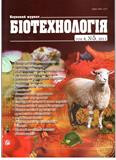ISSN 1995-5537

"Biotechnology" journal V. 4, No. 5, 2011
Р. 103-108, Bibliography 21, Russian.
Universal Decimal classification: 579.222
L. E. Sergeeva, L. I. Bronnikova, O. M. Tishchenko
Institute of Plant Physiology and Genetics of National Academy of Sciences of Ukraine
Solving the problem of stress-resistance to long-term water deficit needs new biotechnology methods. Cell selection with heavy metal ions is the advanced approach. Cell lines selected on media with heavy metal ions and their regenerated plants are characterized by combined resistance.
The free proline levels were measured in tobacco cell cultures and plants during their cultivation on media with addition of the mannitol in lethal doses. Under normal conditions the contents of free proline were small and similar in callus and plant cells of Cd_resistant and control genotypes. Fluctuations of free proline levels were adequate to organism basic parameters. Under osmotic stress the elevations of the free proline levels were marked in all genotypes. In wild type organisms the levels of free proline (within the passage) were stable in callus cells and reduced in leaf cells from 14 to 21 days of the osmotic stress. The high proline pool was the result of degradation of intracellular compartments. The last event led to death of control variants. Contents of the free proline in cells of the resistant lines exceeded the proline level of the wild type and changed both in callus and leaf cells within the passage. Proline accumulation/decrease indicated the activity of its metabolism. The idea about the proline implication in osmotic adjustment of Cd-resistant tobacco cell lines and their regenerants was suggested.
Key words: Nicotiana tabacum L., cadmium ions, cell lines, regenerants, osmotic stress, resistance, proline.
© Palladin Institute of Biochemistry of National Academy of Sciences of Ukraine, 2008

